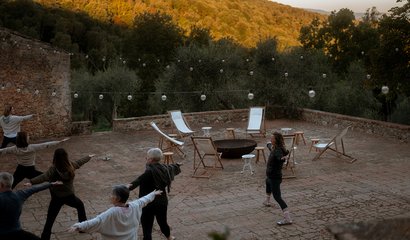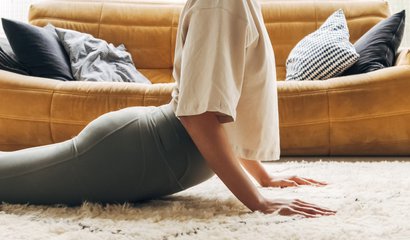Nov. 29, 2017
Building a Sustainable Body
Sustainability and permaculture are two words that (rightly so) we are hearing a lot more of in the mainstream. We usually hear these words in regards to the ways in which we grow and deliver food, care for the environment along with building and design practices. But what about your body? How do you cultivate and maintain a sustainable body?
"The core emphasis of permaculture is that landscapes are complex & integrated wholes. Ecosystems are healthy & relatively stable when their parts are connected in a diverse web of relationships. In a Permaculture design, decisions flow naturally from observations of these relationships. Decisions that arise from connection are inherently functional & frequently beautiful." - Ben Haggard
Sustainability and permaculture are two words that (rightly so) we are hearing a lot more of in the mainstream. We usually hear these words in regards to the ways in which we grow and deliver food, care for the environment along with building and design practices. But what about your body? How do you cultivate and maintain a sustainable body?
Permaculture and your Body
Sustainability is inherent in permaculture. Permaculture is a design philosophy rooted in creating balance, connection and regeneration in a variety of eco-systems, usually regarding food growing. (Click here for a more detailed explanation of permaculture.) To put it simply, it is about building a relationship with the world around us and living in such a way that we can sustain and regenerate health and life.
An ecosystem is a system formed by the interaction of a community of organisms with their environment. Which means the house you live in is an ecosystem, the lifestyle you lead is an ecosystem and your body is an ecosystem. For a sustainable body, we need to examine the ecosystem -in this case your lifestyle- that your body interacts with.
What does a sustainable body look like?
I don't know about you, but I want to live as long as I can in a healthy body. Barring any unforeseen event in the future, this is possible though many different avenues. The food I eat, the products I use to clean my body, clothes and house and most importantly, the ways in which I move.
The short story is that a sustainable body is one that is being used to its fullest capacity. Let's journey through the body and envision what this looks like starting from the ground up:
-The 33 joints, 26 bones and more than 100 muscles in the feet are strong and supple enough to do what they are designed to do, to move your body easily though the world without the need for extra support or structure from a shoe. Your shoe choice then becomes one of environmental protection as opposed to structural stability.
-The bones of the legs and their connection to the pelvis and hip joints are in the position that allows for the greatest stability to bear the weight of the torso and to continue building bone density, especially in the hip joint.
- When the bones of the legs are in a healthy position, then the muscles that move your legs can fire and relax at the proper times, keeping your knees among other parts, healthy and long-lasting.
- Your pelvis and hip joints have the freedom to move separately from each other so that when you walk you maintain structural integrity in the spine and mobility in the legs.
- Your psoas is relaxed and supple aiding the movements of your legs and torso.
- Your belly is relaxed and your transverse abdominis is ready and waiting to effectively stabilize your core as needed.
- The curves in the lumbar and thoracic spine have retained their natural curves keeping back pain at bay and the breath deep and full.
-The shoulder girdle provides a wide range of motion balanced with stability for your arms to move, spread out and with enough strength to hold your body weight in an overhead hanging position. (Picture holding yourself up from a monkey bar or tree branch)
- The muscles of the neck are supple with no hidden tension while effectively holding your head that is full of those beautiful brains of yours.
We could go into even greater details of what a sustainable, healthy and life-generating body looks like, but focusing on our bones and muscles is a great framework and foundation.
How close is your body to this picture?
Building a Sustainable Body
To get from where you are now, to a more sustainable body there are a lot of really simple and accessible things that you can do starting right now.
First of all, ask yourself how you interact with your household and workplace ecosystems. Remember, permaculture is about looking holistically to create balance and self/ life-supporting systems. Our homes and places of work tend to be the places (ecosystems) we spend the most time in. What are the aspects of these environments that are unstable or degenerative in the longterm?
Is sitting in a chair or couch that shortens your hip flexors sustainable to your overall health? Or would sitting on the floor instead where you can enjoy a wide variety of positions or stretch and move be more supportive?
What about your shoe choices? Is that heel, even a small heel going going to have long-term consequences?
Walking or driving?
Squatting?
If you think, well I do yoga and I'm flexible or that you run a couple of times a week, the amount you exercise isn't the answer. That only makes up a small part of the overall picture of how you are spending your time and moving your body. (Even if you are a daily exerciser for 1-2 hours, there are still 22 hours left doing things that may counteract that exercise.)
It the little things more often that add up to your healthy permaculture lifestyle and which creates a sustainable body.
Move more and learn how to move even better. For those of you who practice yoga, stay tuned for the follow-up post on how to have a sustainable yoga practice. Not all yoga is created equal and there may be some things you are doing that creates repetitive stress and strain on your muscles and joints.
The ultimate guide to a sustainable body and lifestyle that is both entertaining and eye-opening and sure to change create a paradigm shift in your body and mind is the book Move Your DNA by Katy Bowman. Check it out!
Build a Sustainable Body + Yoga practice
Discover what a sustainable approach to yoga feels like in your body!






